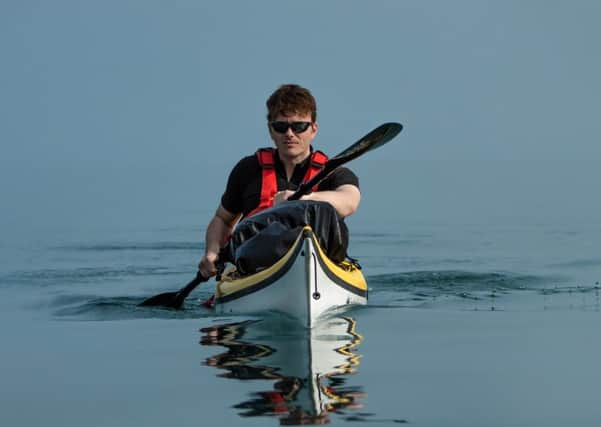Book review: The Frayed Atlantic Edge: A Historian’s Journey From Shetland to the Channel, by David Gange


Originally from the Peak District, Gange is a senior lecturer in modern history at the University of Birmingham, specialising in 19th century Britain, and his goal in writing this book was to tell an alternative history of our archipelago. Much of the history of these islands, he argues, is written from the point of view of the major urban centres, with the western peripheries seen as ... well.. peripheral. But, he writes, “in the larger scheme of things, it has been just the blink of an eye since the Atlantic edge was these islands’ centre.”
As he paddles his little boat slowly southwards, Gange is constantly finding evidence of how – until relatively recently – it was the Atlantic coast that gave the British Isles a window on the rest of the world, and even of how it once boasted significant industrial centres. Kayaking around Papa Westray (Papay) in Orkney, for example, he passes “an enormous kelp store, a remnant of the decades around 1800 when Papay was a global centre of this major industry.” At the peak of the kelp trade, he observes, when huge piles of kelp were being burned here, the place was “as alive with the smoke and fire of industry as Manchester and Coalbrookdale.”
Advertisement
Hide AdAlthough his professional area of interest is the 19th century, Gange ranges omnivorously through the centuries, from geological deep time and the formation of the mountains of Skye, right up to the present day. While paddling along Ireland’s west coast, he makes the point that, while the Dark Ages may have been a dark time for certain urban centres, here they were a time of “the scholar saints’ expansion throughout the east Atlantic.” And for all that he is largely concerned with the declining fortunes and populations of coastal areas – the effects of the Highland Clearances and “improved” farming in Scotland, or the slow death of the pilchard fishing industry in Cornwall – he also has half an eye on a more optimistic future.
He devotes a sizeable chunk of his chapter on the Western Isles to the remarkable story of Comunn Eachdraidh Nis, the local history society of Ness, and how it both gave the local community back a sense of pride in its own history and also gave rise to a much larger network of similar organisations. He also uses the example of the ultimately successful protests of the people of Erris in County Mayo against a proposed offshore development by Shell to show how a supposedly marginalised coastal community managed to defeat a seemingly all-powerful multinational armed only with an acute awareness of their history and their local environment.
In his preface, Gange explains that his book will start out as a more-or-less straight narrative account of his voyage and that the big ideas around reimagining the sweep of the history of the British Isles will be saved for the end. However, so expertly does he marshal his material that by the time he reaches his final chapter, “The View From The Sea,” he is left with the intellectual equivalent of an open goal: when he writes that the “coastlines that the dominant cultures of the 19th and 20th centuries marginalised” are “places where centralised political economies never worked” he doesn’t need to give examples because he has already supplied plenty. And when he writes that these places are still full of potential, if you’ve been paying attention, you can only agree.
If Gange’s book has a weak spot, it is the rather off-hand way in which it deals with the southern portion of Wales and some parts of Cornwall. After devoting the best part of 15 pages to the tiny island of Ynys Enlli (Bardsey), he is dismayed to realise that, as it’s June, he is going to have to “experience the South Wales coasts and their communities as tourists experience them” and writes rather dismissively of how “the roar of jet skis rends sleepy bays, and plastic buckets and other lost accoutrements of the holiday camp bob at sea.” Indeed, the whole giant sweep of Cardigan Bay, all the way from Harlech to Pembrokeshire, is summed up in a single line: “Cardigan Bay was quick and easy work, showing few elements of Atlanticness, no islands, little raggedness and a sea that easily forgets whatever winds have passed across it.”
There’s a similar air of dismissiveness when he reaches the north coast of Cornwall and finds “Home Counties accents” and “lines of surfers and swimmers who bobbed in bays like emaciated neoprene seals.” The bucket-and-spaders of South Wales and the surfers and swimmers of Cornwall might not be to his taste, but surely the phenomenon of mass seaside tourism is of at least some relevance to the story of these islands’ western coastline. Certainly the economies of these places would be radically different without it.
Indeed, it seems strange that Gange should spend so much time in the early chapters bemoaning the depopulation of certain coastal areas of Scotland and Ireland, only to finally find densely populated coastal areas further south but then apparently decide that they are not quite populated to his liking – certainly not in a way that is worth discussing in any great detail.
Advertisement
Hide AdThis is – mostly – a brilliant book, and a major step towards a genuinely radical reimagining of the history of the British Isles. If only Gange’s editor had asked him to get back in his boat, revisit the last couple of chapters and fill in some of the blanks. Roger Cox
The Frayed Atlantic Edge: A Historian’s Journey From Shetland to the Channel, by David Gange, William Collins, 388pp, £18.99. David Gange will be appearing at the Edinburgh International Book Festival on 16 August